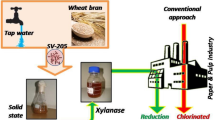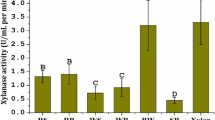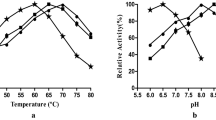Abstract
A cellulase-free xylanolytic enzyme consortia consisting of a xylanase, arabinofuranosidase, and acetyl xylan esterase produced by Bacillus sp. NIORKP76 isolate under solid-state fermentation was assessed for its bio-bleaching ability on kraft pulp. In the biobleaching analysis, the xylanase dose of 5 Ug−1 dry pulp denoted the optimum bleaching of pulp at 40 °C and pH 8.0 after 2 h of treatment. The reduction in kappa number of pre-treated hardwood pulp using xylanolytic enzyme consortium (XEC) was found to be ~ 55%, while solo xylanase could reduce the kappa number to 44–46%. In the case of chemical bagasse pulp, a reduction of ~ 27.5% and 19–20% was seen in kappa number using XEC and solo xylanase, respectively. Enzyme-treated pulp (HW and CB) showed a 50% reduction in hypochlorite consumption during the chlorine treatment. The current study results reveal the significant potential of xylanolytic enzyme consortium from Bacillus sp. NIORKP76 on the environmentally friendly bio-bleaching process.









Similar content being viewed by others
References
Singh G, Kaur S, Khatri M, Arya SK (2019) Biobleaching for pulp and paper industry in India: emerging enzyme technology. Biocat Agri Biotechnol 17:558–565. https://doi.org/10.1016/j.bcab.2019.01.019
Beg QK, Bhushan B, Kapoor M, Hoondal GS (2000) Enhanced production of a thermostable xylanase from Streptomyces sp. QG-11-3 and its application in biobleaching of eucalyptus kraft pulp. Enz Microbial Technol 27(7):459–466. https://doi.org/10.1016/s0141-0229(00)00231-3
Viikari L, Kantelinen A, Sundquist J, Linko M (1994) Xylanases in bleaching: From an idea to the industry. FEMS Microbiol Rev 13(2–3):335–350. https://doi.org/10.1111/j.1574-6976.1994.tb00053.x
Koponen R (1991) Enzyme systems prove their potential. Pulp Paper Int 33(11):20–25
Nagar S, Gupta VK (2020) Hyper production and eco-friendly bleaching of kraft pulp by xylanase from Bacillus pumilus SV-205 using agro waste material. Waste Biomass Valorization. https://doi.org/10.1007/s12649-020-01258-0
Dutta PD, Neog B, Goswami T (2020) Xylanase enzyme production from Bacillus australimaris P5 for prebleaching of bamboo (Bambusa tulda) pulp. Materials Chem Phy 243:122227. https://doi.org/10.1016/j.matchemphys.2019.122227
Khandepaker R, Bhosle NB (2007) Application of thermoalkalophilic xylanase from Arthrobacter sp. MTCC 5214 in biobleaching of kraft pulp. Biores Technol 98:897–903. https://doi.org/10.1016/j.biortech.2006.02.037
Nair SG, Sindhu R, Shashidhar S (2010) Enzymatic bleaching of kraft pulp by xylanase from Aspergillus sydowii SBS 45. Indian J Microbiol 50:332–338. https://doi.org/10.1007/s12088-010-0049-2
Chawannapak W, Laothanachareon T, Boonyapakron K, Wongwilaiwalin S, Nimchua T, Eurwilaichitr L, Pootanakit K, Igarashi Y, Champreda V (2012) Alkaliphilic endoxylanase from lignocellulolytic microbial consortium metagenome for biobleaching of eucalyptus pulp. J Microbiol Biotechnol 22(12):1636–1643. https://doi.org/10.4014/jmb.1206.06044
Sridevi A, Sandhya G, Ramanjaneyulu G, Narasimha P, Devi S (2016) Biocatalytic activity of Aspergillus niger xylanase in paper pulp biobleaching. 3Biotech 6:165. https://doi.org/10.1007/s13205-016-0480-0
Woodward J (1984) Xylanases: functions, properties and applications. Topics Enz Ferment Biotechnol 8:9–30
Wong KK, Tan LU, Saddler JN (1988) Multiplicity of beta-1,4-xylanase in microorganisms: functions and applications. Microbiol Rev 52(3):305–317
Coughlan MP, Hazlewood GP (1993) beta-1,4-D-Xylan-degrading enzyme systems: biochemistry, molecular biology and applications. Biotechnol Appl Biochem 17(3):259–289
Clarke JH, Davidson K, Rixon JE, Halstead JR, Fransen MP, Gilbert HJ, Hazlewood GP (2000) A comparison of enzyme-aided bleaching of softwood paper pulp using combinations of xylanase, mannanase and α-galactosidase. Appl Microbiol Biotechnol 53:661–667. https://doi.org/10.1007/s002530000344
Bajpai P, Anand A, Sharma N, Mishra SP, Bajpai PK, Lachenal D (2006) Enzymes improve ECF bleaching of pulp. BioRes 1(1):34–44
Mi S, Jia X, Wang J, Qiao W, Peng X, Han Y (2014) Biochemical characterization of two thermostable xylanolytic enzymes encoded by a gene cluster of Caldicellulosiruptor owensensis. PLoS One 9(8):e105264. https://doi.org/10.1371/journal.pone.0105264
Chaturvedi S, Singh R, Khurana SPM (2015) Production of bacterial—xylanolytic enzyme using agricultural waste by solid state fermentation. Int J Curr Microbiol App Sci 4(4):9–16
Liao H, Zheng H, Li S (2015) Functional diversity and properties of multiple xylanases from Penicillium oxalicum GZ-2. Sci Rep 5:12631. https://doi.org/10.1038/srep12631
Teeravivattanakit T, Baramee S, Phitsuwan P, Waeonukul R, Pason P, Tachaapaikoon C, Sakka K, Ratanakhanokchaia K (2016) Novel trifunctional xylanolytic enzyme Axy43A from Paenibacillus curdlanolyticus strain B-6 exhibiting endo-xylanase, β-D-xylosidase, and arabinoxylan arabinofuranohydrolase activities. Appl Environ Microbiol 82:6942–6951. https://doi.org/10.1128/AEM.02256-16
Nawawi MH, Mohamad R, Tahir PM, Saad WZ (2017) Extracellular xylanopectinolytic enzymes by Bacillus subtilis ADI1 from EFB’s compost. Int Scho Res Notices. https://doi.org/10.1155/2017/7831954
Elegir G, Sykes M, Jeffries TW (1995) Differential and synergistic action of Streptomyces endoxylanases in prebleaching of kraft pulps. Enz Microbial Technol 17(10):954–959. https://doi.org/10.1016/0141-0229(94)00122-8
Parab PD, Khandeparker RD, Shenoy BD, Sharma J (2020) Phylogenetic diversity of culturable marine bacteria from Mangrove Sediments of Goa, India: a potential source of xylanases belonging to glycosyl hydrolase family 10. Appl Biochem Microbiol 56(6):718–728. https://doi.org/10.1134/S0003683820060137
Mai-Gisondi G, Master ER (2017) Colorimetric detection of acetyl xylan esterase activities. Protein-carbohydrate interactions. Methods Mol Biol 1588:45–57. https://doi.org/10.1007/978-1-4939-6899-2_5
Buzała KP, Kalinowska H, Borkowski J, Przybysz P (2018) Effect of xylanases on refining process and kraft pulp properties. Cellulose 25:1319–1328. https://doi.org/10.1007/s10570-017-1609-y
Miller GL (1959) Use of dinitrosalicylic acid reagent for determination of reducing sugar. Anal Chem 31:426–428
Liu H, Shi H, Wang Y, Wu W, Ni Y (2014) Interactions of lignin with optical brightening agents and their effect on paper optical properties. Ind Eng Chem Res 53(8):3091–3096. https://doi.org/10.1021/ie4032082
Tessier P, Savoie M (2002) Brightness reversion of hardwood and softwood kraft pulps during bleaching. Tappi J 1(8):28–32
Reid ID, Paice MG (1994) Effect of residual lignin type and amount on bleaching of kraft pulp by Trametes versicolor. Appl Env Microbiol 60(5):1395–1400. https://doi.org/10.1128/aem.60.5.1395-1400.1994
Hu G, Fu S, Chu F, Lin M (2017) Relationship between paper whiteness and color reproduction in inkjet printing. BioResources 12(3):4854–4866
Nissan R, Trope M, Zhang CD, Chance B (1992) Dual wavelength spectrophotometry as a diagnostic test of the pulp chamber contents. Oral Surgery Oral Med Oral Pathol 74(4):508–514. https://doi.org/10.1016/0030-4220(92)90304-9
Kulkarni N, Rao M (1996) Application of xylanase from alkaliphilic thermophilic Bacillus sp. NCIM 59 in biobleaching of bagasse pulp. J Biotechnol 51(2):167–173. https://doi.org/10.1016/0168-1656(96)01616-1
Patel RN, Grabski AC, Jeffries TW (1993) Chromophore release from kraft pulp by purified Streptomyces roseiscleroticus xylanases. Appl Microbiol Biotechnol 39(3):405–412. https://doi.org/10.1007/BF00192102
Dwivedi P, Vivekanand V, Pareek N, Sharma A, Singh RP (2010) Bleach enhancement of mixed wood pulp by xylanase–laccase concoction derived through co-culture strategy. Appl Biochem Biotechnol 160(1):255. https://doi.org/10.1007/s12010-009-8654-4
Terrasan CR, Temer B, Sarto C, Júnior FGS, Carmona EC (2013) Xylanase and β-xylosidase from Penicillium janczewskii: production, physico-chemical properties, and application of the crude extract to pulp biobleaching. BioRes 8(1):1292–1305. https://doi.org/10.15376/biores.8.1.1292-1305
Sridevi A, Ramanjaneyulu G, Devi PS (2017) Biobleaching of paper pulp with xylanase produced by Trichoderma asperellum. 3Biotech 7(4):266. https://doi.org/10.1007/s13205-017-0898-z
Bhoria P, Singh G, Sharma JR, Hoondal GS (2012) Biobleaching of wheat straw-rich-soda pulp by the application of alkalophilic and thermophilic mannanase from Streptomyces sp. PG-08-3. African J Biotechnol 11(22):6111–6116. https://doi.org/10.5897/AJB09.1238
Gupta V, Garg S, Capalash N, Gupta N, Sharma P (2015) Production of thermo-alkali-stable laccase and xylanase by co-culturing of Bacillus sp. and B. halodurans for biobleaching of kraft pulp and deinking of waste paper. Bioprocess Biosyst Eng 38:947–956. https://doi.org/10.1007/s00449-014-1340-0
Angural S, Rana M, Sharma A, Warmoot R, Puri N, Gupta N (2020) Combinatorial biobleaching of mixedwood pulp with lignolytic and hemicellulolytic enzymes for paper making. Indian J Microbiol 60:383–387. https://doi.org/10.1007/s12088-020-00867-6
Ninawe S, Kuhad RC (2006) Bleaching of wheat straw-rich soda pulp with xylanase from a thermoalkalophilic Streptomyces cyaneus SN32. Biores Technol 97(18):2291–2295. https://doi.org/10.1016/j.biortech.2005.10.035
Kapoor M, Kapoor RK, Kuhad RC (2007) Differential and synergistic effects of xylanase and laccase mediator system (LMS) in bleaching of soda and waste pulps. J Applied Microbiol 103(2007):305–317. https://doi.org/10.1111/j.1365-2672.2006.03251.x
Thakur VV, Jain RK, Mathur RM (2012) Studies on xylanase and laccase enzymatic prebleaching to reduce chlorine-based chemicals during CEH and ECF bleaching. BioResource 7(2):2220–2235. https://doi.org/10.15376/BIORES.7.2.2220-2235
Acknowledgements
The authors are thankful to Director, CSIR-National Institute of Oceanography, Goa (India), and Head, BOD, for giving all necessary services and encouragement. The authors thank the Council of Scientific and Industrial Research (CSIR, India) for providing financial support through the Senior Research Fellowship (SRF) to the first author. This article is part of doctoral work being submitted by the first author at Goa University in the Department of Microbiology under the corresponding author's guidance. This publication has CSIR-NIO contribution number 6790.
Author information
Authors and Affiliations
Corresponding author
Ethics declarations
Conflict of interest
The authors declare that they have no conflict of interest.
Additional information
Publisher's Note
Springer Nature remains neutral with regard to jurisdictional claims in published maps and institutional affiliations.
Supplementary Information
Below is the link to the electronic supplementary material.
449_2021_2623_MOESM1_ESM.tif
Supplementary file1 Fig. 1 Correlation between brightness development and lignin content of kraft pulp samples (TIF 166 KB)
Rights and permissions
About this article
Cite this article
Parab, P., Khandeparker, R. Xylanolytic enzyme consortia from Bacillus sp. NIORKP76 for improved biobleaching of kraft pulp. Bioprocess Biosyst Eng 44, 2513–2524 (2021). https://doi.org/10.1007/s00449-021-02623-6
Received:
Accepted:
Published:
Issue Date:
DOI: https://doi.org/10.1007/s00449-021-02623-6




